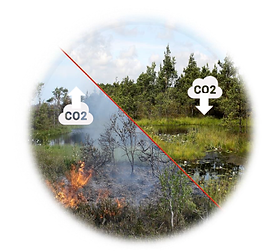
Restoration of hydrological conditions of the Paąžuolynė peatland
and maintenance of its natural habitats
PROJECT DURATION
2024 - 2025
PARTNERS
Directorate of Protected Territories of Aukštaitija
About the site
In the middle of XXth century, the Paąžuolynė peatland located in the central part of Lithuania (Jonava district) was intended to be used for the peat industry: a network of ditches draining the bog was installed, the vegetation cover was removed and peat mining began. Currently, peat cutting activities are not carried out for several decades, thus heavily drained and damaged peatland was abandoned. Despite several decades of nature destruction, the site is still characterized by unique natural values. The following protected species can be found there: Common crane, Large whiteface, European fire-bellied toad, Northern crested newt, etc. Moreover, two types of habitats of European importance are inventoried in the site: Degraded raised bogs (7120) and Bog woodlands (*91D0). Currently the site (75 ha) has a NATURA 2000 and Botanical-Zoological reserve protection status.
Threats
-
peat decomposition and increased GHG emissions;
-
habitat and biodiversity loss;
-
increased risk of fires.
The aim of the project is to create conditions for the restoration of the natural hydrological regime of the Paąžuolynė peatland and thus reduce GHG emissions and maintain the favorable condition for protected species and habitats.
Project objectives:
-
prepare and coordinate planning documents (Action plan, hydrotechnical plan) and other documentation that may be needed in the course of project implementation;
-
carry out the assessment of greenhouse gas emissions (based on the GEST methodology) before and after the implementation of nature management works;
-
to restore the hydrological regime of the site;
-
to maintain typical raised bog open habitats of the site by clearing the woody vegetation;
-
to ensure further maintenance of the area by cooperating with the Directorate of Protected Areas of Aukštaitija (removal of woody vegetation in an area of at least 2 ha, and ensuring a good population status of the target species).
Project documentation:
Annex 1. Preliminary modeling of GHG emissions reduction based on the GEST methodology











